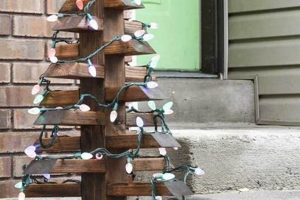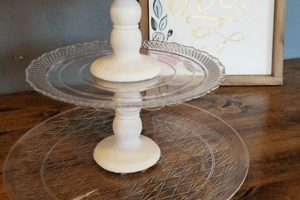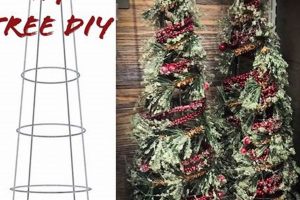Constructions of festive, evergreen-shaped objects crafted from timber represent a seasonal decorating approach. These handmade items, created from materials such as planks, branches, or repurposed wooden elements, offer an alternative to traditional coniferous trees. As an illustration, consider a tiered structure built from progressively smaller wooden squares, stacked to resemble a pyramidal fir and adorned with lights and ornaments.
The appeal of such projects lies in their sustainability, cost-effectiveness, and personalized aesthetic. These creations can be tailored to specific spaces and design preferences, making them ideal for smaller homes or for individuals seeking unique holiday decor. Historically, crafting festive decorations from available materials has been a practice rooted in resourcefulness and a desire to celebrate traditions regardless of economic constraints. These modern wooden interpretations carry on this spirit, offering a blend of creativity and practicality.
The subsequent sections will explore various designs, construction techniques, finishing options, and safety considerations associated with building these decorative items. Emphasis will be placed on ensuring a successful and enjoyable crafting experience, culminating in a durable and visually appealing holiday centerpiece.
Essential Construction Considerations
Successful creation of wooden evergreen-shaped decorative pieces requires careful planning and execution. Adherence to the following guidelines will facilitate a durable and aesthetically pleasing outcome.
Tip 1: Material Selection. Prioritize seasoned lumber to minimize warping or cracking after construction. Softwoods like pine are generally easier to work with, but hardwoods such as oak or maple provide superior strength and longevity.
Tip 2: Precise Measurements and Cuts. Accuracy in cutting is crucial for ensuring structural integrity and visual symmetry. Employ a miter saw or circular saw with a guide for precise angled cuts. Double-check all measurements before making any cuts.
Tip 3: Secure Fastening Techniques. Utilize appropriate fasteners, such as wood screws or nails, in conjunction with wood glue to create strong, lasting bonds. Countersink screws to prevent splitting and allow for a smooth surface finish.
Tip 4: Stable Base Design. A stable and well-proportioned base is critical to prevent tipping. A wider base provides greater stability, particularly for taller constructions. Consider using weighted materials within the base for added security.
Tip 5: Thorough Sanding and Finishing. Sand all surfaces thoroughly to remove splinters and create a smooth surface for finishing. Apply a protective sealant or paint to enhance durability and protect against moisture damage.
Tip 6: Safe Electrical Integration. When incorporating lighting, use low-voltage LED lights and ensure all wiring is properly insulated and secured. Follow all electrical safety guidelines to prevent fire hazards.
Tip 7: Consider Disassembly for Storage. For larger constructions, design the project in modular sections that can be easily disassembled for compact storage when not in use. This will prolong the life and reduce the risk of damages during storage.
By adhering to these considerations, a robust and visually appealing festive decoration can be crafted, providing years of seasonal enjoyment.
The following sections will explore design aesthetics and creative customization possibilities.
1. Material Selection
Material selection is a foundational element in the creation of wooden evergreen-shaped holiday decorations. The chosen materials directly influence the aesthetic appeal, structural integrity, and longevity of the finished product. For instance, the use of reclaimed barn wood imparts a rustic aesthetic, while the selection of premium hardwood like maple or cherry results in a more refined and durable piece. Inadequate material choice, such as using unseasoned lumber, can lead to warping or cracking, diminishing the piece’s visual appeal and stability. Therefore, careful consideration of material properties is critical to the project’s success.
The type of wood dictates not only the visual style but also the ease of construction. Softwoods like pine are generally easier to cut, shape, and fasten, making them suitable for simpler designs and novice woodworkers. Conversely, hardwoods require more specialized tools and techniques but offer greater resistance to wear and tear. Furthermore, environmental considerations often play a role in material selection. Opting for sustainably sourced lumber or repurposing existing wood reduces the environmental impact of the project. Examples include using fallen branches trimmed to different length as part of the tree. This is not only sustanaible but also brings a more natural feeling to the tree.
Ultimately, informed material selection represents a crucial investment in the quality and sustainability of the final decorative piece. It requires balancing aesthetic preferences with practical considerations such as cost, workability, and environmental impact. Overlooking this initial step can lead to structural weaknesses, premature deterioration, or a design that fails to meet the intended aesthetic goals. Careful thought in Material Selection in “diy christmas tree wood” leads to a final product that brings joy for years to come.
2. Design Complexity
The level of intricacy involved in the design of a wooden evergreen-shaped holiday decoration significantly influences the construction process and the final aesthetic outcome. A simpler design, for instance, might involve stacking progressively smaller wooden planks to mimic the conical shape of a traditional tree. This requires basic cutting and joining skills. A more complex design, however, could incorporate intricate latticework, curved elements, or integrated lighting systems. Such complexities necessitate advanced woodworking techniques, specialized tools, and a greater investment of time and resources.
Increased design complexity directly affects the skill level required for successful execution. A novice woodworker might find a simple stacked-plank design manageable, while attempting a design with compound angles or intricate joinery could lead to frustration and a substandard finished product. Furthermore, complex designs often demand precise measurements and cutting accuracy. Small errors can compound over the course of the project, resulting in structural weaknesses or a visually unappealing final product. For example, a lattice design with uneven spacing or poorly aligned joints will detract from the overall aesthetic.
Ultimately, the choice of design complexity must align with the woodworker’s skill level, available tools, and desired aesthetic. While complex designs can yield stunning results, simpler designs can be equally effective and more attainable for those with limited experience or resources. Careful consideration of design complexity is therefore essential for ensuring a successful and enjoyable crafting experience. The interplay of design and execution is key to the final product.
3. Cutting Precision
Cutting precision is paramount in the successful construction of wooden evergreen-shaped holiday decorations. Accurate cuts directly influence the structural integrity, aesthetic appeal, and overall stability of the finished piece. Deviations from intended measurements can lead to misalignment, weakened joints, and a visually flawed outcome.
- Mitered Joint Accuracy
For designs incorporating mitered joints, precise angle cuts are crucial. Inaccurate miter angles result in gaps and uneven seams, compromising both the aesthetic and structural integrity of the assembly. The use of a high-quality miter saw and careful attention to angle settings are essential for achieving tight, seamless joints. Any deviation of more than a degree or two can cause visible flaws.
- Dimensional Consistency
Designs utilizing repetitive elements, such as stacked planks or individual branches, require consistent dimensions. Variations in the length or width of these elements can create a disjointed and unbalanced appearance. Employing a stop block or jig system ensures uniform cuts, particularly when dealing with large quantities of similar components.
- Angle Symmetry
Many wooden evergreen designs rely on symmetrical arrangements to mimic the natural form of a coniferous tree. Cutting angles must be precise and consistent to maintain this symmetry. Inconsistent angles will result in a lopsided or unbalanced structure, detracting from the overall visual appeal. Utilizing a protractor or angle finder aids in achieving accurate and symmetrical cuts.
- Flush Surface Alignment
Achieving flush surface alignment between adjacent wooden elements requires accurate and consistent cutting. Irregular cuts can lead to protruding edges or recessed surfaces, creating an uneven and unprofessional appearance. Careful attention to cutting lines and the use of appropriate cutting tools, such as a table saw or jointer, is essential for achieving flush surface alignment.
In summary, cutting precision is not merely a technical detail but a fundamental requirement for crafting visually appealing and structurally sound wooden evergreen-shaped holiday decorations. Adherence to precise cutting techniques ensures a professional finish and lasting durability. The cumulative effect of precise cuts is a finished piece that reflects craftsmanship and attention to detail.
4. Joint Strength
Joint strength is a critical determinant of the longevity and structural integrity of any wooden evergreen-shaped holiday decoration. Inferior joints, regardless of aesthetic appeal, invariably lead to premature failure. A weakly joined structure, for example, may collapse under its own weight, particularly if it is a tall or complex design. The selection of appropriate joining techniques and materials is therefore paramount. For example, designs incorporating tiered wooden shelves require robust joints at each level to support the weight of ornaments and decorations. Failure to provide sufficient joint strength results in instability and potential collapse. Properly executed mortise-and-tenon or dovetail joints offer superior strength compared to simple butt joints fastened with nails alone. Joint Strength is the foundational attribute of diy christmas tree wood’s structural capability.
Practical applications of understanding joint strength extend to safety considerations. A poorly constructed structure poses a risk of toppling, potentially causing damage to property or injury to individuals. The incorporation of strong joints minimizes this risk and ensures a stable and secure decoration. Designs intended for outdoor display must withstand wind and weather, placing even greater demands on joint strength. The use of waterproof adhesives and rust-resistant fasteners is crucial in these applications. An example would be a large outdoor display failing at a joint during a winter storm, posing a hazard and requiring costly repairs.
In summary, joint strength is an indispensable element in the construction of durable and safe wooden evergreen-shaped holiday decorations. Neglecting this aspect compromises the structural integrity and longevity of the project. The understanding and application of appropriate jointing techniques and materials are therefore essential for ensuring a visually appealing and structurally sound final product. Ensuring an understanding of these concepts is key.
5. Surface Finishing
Surface finishing is an essential aspect of crafting wooden evergreen-shaped holiday decorations, influencing both the aesthetic appeal and the protective qualities of the piece. The application of various finishing techniques enhances the wood’s natural beauty, protects it from environmental factors, and ensures its longevity. The choice of finish depends on the desired aesthetic, the type of wood used, and the intended use of the decoration.
- Protection Against Environmental Factors
Surface finishes, such as sealants and varnishes, create a barrier against moisture, sunlight, and temperature fluctuations. For wooden evergreen decorations intended for outdoor display, this protection is crucial in preventing warping, cracking, and discoloration. A properly applied finish extends the life of the decoration, preserving its appearance for years to come. An example would be the application of marine-grade varnish to a wooden tree displayed on a porch, protecting it from rain and UV damage.
- Enhancement of Aesthetic Appeal
Finishing techniques can enhance the natural grain and color of the wood, adding depth and richness to the appearance. Stains, for example, can accentuate the wood’s texture or create a custom color palette. Clear coats provide a glossy or matte sheen, enhancing the wood’s inherent beauty while providing protection. The choice of finish can dramatically alter the overall aesthetic, transforming a simple wooden structure into a sophisticated decorative piece.
- Ease of Maintenance
Surface finishes facilitate cleaning and maintenance, preventing the absorption of dirt and grime. A smooth, sealed surface is easier to wipe down and keep free of dust and debris. This is particularly important for decorations displayed in high-traffic areas or homes with children and pets. A well-finished surface also resists staining and scratching, maintaining its appearance over time.
- Safety Considerations
Certain surface finishes, such as those containing volatile organic compounds (VOCs), can pose health risks during application and curing. Opting for low-VOC or water-based finishes minimizes these risks and promotes a safer working environment. Furthermore, finishes intended for use around children or pets should be non-toxic and food-safe. Careful consideration of safety is essential when selecting surface finishes for wooden evergreen decorations.
In summary, surface finishing is a critical step in the creation of wooden evergreen-shaped holiday decorations. It not only enhances the aesthetic appeal of the piece but also provides essential protection against environmental factors and facilitates easy maintenance. Thoughtful selection and application of appropriate finishes are essential for ensuring a durable, visually appealing, and safe decorative item that can be enjoyed for years to come.
6. Stability Factors
The structural integrity of timber-based festive decorations hinges critically on several stability factors. These elements dictate whether the resulting structure can withstand external forces, maintain its intended form, and provide a safe and visually appealing holiday display. Neglecting these stability considerations during the design and construction phases invariably leads to functional and aesthetic compromises.
- Base Dimensions and Weight Distribution
The size and configuration of the base significantly influence overall stability. A wider base provides a larger support area, reducing the likelihood of tipping. Even weight distribution is equally crucial. For instance, a top-heavy design is inherently unstable and prone to toppling. Counterweights strategically placed within the base can mitigate this issue. The correlation between base dimensions, weight distribution, and overall stability is a fundamental principle in structural engineering.
- Material Rigidity and Joint Integrity
The selection of materials possessing sufficient rigidity is paramount. Softwoods, while easier to work with, may lack the necessary stiffness to prevent swaying or bending, particularly in taller structures. Secure and properly executed joints are equally critical. Weak joints compromise the structure’s ability to resist lateral forces, leading to instability and potential collapse. Mortise-and-tenon joints, for example, provide greater stability than simple butt joints.
- Environmental Considerations
Outdoor displays are subjected to wind, rain, and snow, all of which exert forces on the structure. Exposure to these elements necessitates additional stabilization measures. Anchoring the base to the ground or employing wind-resistant designs minimizes the risk of toppling or damage. The choice of materials must also account for resistance to moisture and temperature fluctuations, preventing warping and weakening of the structure.
- Load Capacity and Ornament Distribution
The structure’s ability to support the weight of ornaments and decorations is a key stability factor. Overloading the structure can lead to bending, warping, or even collapse. Distributing ornaments evenly minimizes stress on specific areas and maintains balance. Heavier ornaments should be placed lower down, closer to the base, to lower the center of gravity and enhance stability.
The integration of these stability factors represents a crucial element in the successful creation of durable and visually appealing wooden evergreen-shaped holiday decorations. Neglecting any one of these aspects compromises the overall integrity and longevity of the piece, potentially leading to unsafe or aesthetically unpleasing results. Meticulous attention to these details ensures a stable and enduring holiday display. The overall aesthetic appeal will also increase along with the structure’s ability to withstand forces of nature.
7. Ornamentation Style
Ornamentation style serves as a crucial element in defining the final aesthetic of any wooden evergreen-shaped holiday creation. The inherent neutrality of wood, as a construction material, provides a blank canvas upon which diverse decorative approaches can be implemented. The ornamentation chosen dictates the overall tone, ranging from rustic and minimalist to ornate and traditional. A Scandinavian-inspired structure, for instance, might feature simple wooden bead garlands and natural fiber ornaments, reflecting a minimalist aesthetic. Conversely, a more traditional design could incorporate brightly colored glass ornaments, tinsel, and an elaborate tree topper. Thus, the selection of ornamentation style exerts a direct influence on the perceived character of the wooden holiday structure.
The impact of ornamentation style extends beyond mere aesthetics; it also affects the perceived functionality and appropriateness of the display. A sparsely decorated wooden structure might be well-suited for a modern, minimalist interior, while a heavily ornamented tree could be more appropriate for a traditional setting. The weight and method of attachment of the ornaments also necessitate careful consideration. Heavy ornaments placed on poorly supported branches could compromise the structural integrity of the display. Furthermore, the scale and proportion of the ornaments should be carefully considered relative to the size and shape of the wooden structure. Overly large ornaments can overwhelm a smaller structure, while undersized ornaments might appear insignificant on a larger display. The coordination of scale, proportion, and weight is therefore essential for achieving a harmonious and balanced visual effect.
In conclusion, ornamentation style constitutes a critical component in the overall design of wooden evergreen-shaped holiday decorations. The style chosen directly influences the aesthetic appeal, perceived functionality, and structural integrity of the display. Thoughtful consideration of scale, proportion, weight, and aesthetic consistency is paramount for achieving a cohesive and visually pleasing final product. While the wooden structure itself provides the foundation, it is the ornamentation that ultimately defines the character and impact of the seasonal display. Successful integration of ornamentation style transforms a simple wooden framework into a unique and personalized holiday centerpiece.
Frequently Asked Questions
The following addresses common inquiries regarding the construction, safety, and maintenance of wooden alternatives to traditional evergreen holiday trees.
Question 1: What types of wood are most suitable for building a wooden Christmas tree?
Softwoods such as pine or fir are generally easier to work with due to their lower density. However, hardwoods like oak or maple offer greater durability and resistance to wear. The choice depends on the desired aesthetic and structural requirements.
Question 2: Are there specific safety precautions to consider when constructing a wooden Christmas tree?
Eye protection and dust masks are essential when cutting and sanding wood. Ensure proper ventilation when applying finishes, and use caution when integrating electrical components, such as lighting. Secure all connections and avoid overloading circuits.
Question 3: How can I ensure the stability of a tall wooden Christmas tree?
A wide and sturdy base is crucial. Distribute weight evenly and consider using counterweights within the base for added stability. Secure the structure to a wall or floor if necessary, especially in areas prone to high winds or heavy traffic.
Question 4: What are the best methods for joining wood pieces when building a wooden Christmas tree?
Wood screws, nails, and wood glue provide adequate strength for most designs. Mortise-and-tenon joints or dovetail joints offer superior strength for more complex or load-bearing connections. Ensure all joints are properly aligned and securely fastened.
Question 5: How can I protect a wooden Christmas tree from moisture damage?
Apply a sealant or varnish to all exposed surfaces. Use exterior-grade materials for outdoor displays. Store the tree in a dry environment when not in use to prevent warping or rot.
Question 6: What are some creative ways to decorate a wooden Christmas tree?
Options range from traditional ornaments and lights to more unconventional approaches such as painted designs, reclaimed materials, or integrated shelving for displaying smaller items. The design should complement the overall aesthetic of the surrounding space.
Proper planning, careful construction, and adherence to safety guidelines are essential for creating a durable and visually appealing wooden Christmas tree.
The following section will offer various design ideas.
Conclusion
The preceding exploration of “diy christmas tree wood” encompassed various aspects of design, construction, safety, and aesthetics. Emphasis was placed on material selection, joint integrity, surface finishing, and stability considerations, highlighting the critical role each element plays in the creation of a durable and visually appealing holiday decoration. Diverse ornamentation styles, ranging from minimalist to traditional, were examined to illustrate the potential for personalization and creative expression.
The information presented serves as a foundation for informed decision-making in the crafting of wooden evergreen-shaped holiday decorations. Careful consideration of these factors ensures a finished product that reflects both skillful execution and thoughtful design. Prudent application of these principles fosters the creation of unique and enduring holiday pieces, offering an alternative to conventional decorations while promoting resourcefulness and individual artistry.







